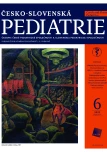Poliomyelitis and eradication problems
Authors:
Špaleková Margita
Authors‘ workplace:
Ústav epidemiológie, Lekárska fakulta Univerzity Komenského v Bratislave
Published in:
Čes-slov Pediat 2022; 77 (6): 328-331.
Category:
Comprehensive Report
doi:
https://doi.org/10.55095/CSPediatrie2022/058
Overview
Poliomyelitis is serious infection caused by neurotropic virus. In the past, infection was contracted mostly by children less 5 years old, outbreaks occurred in underdeveloped regions. Infection could be asymptomatic or flu-like disease and about 1% ill persons manifested in paralytic form.
More than six decades since mass vaccination of children by inactivated vaccine (IPV) and more imunogenic oral live vaccine (OPV), both with antigens of three poliovirus types (1, 2, 3) has been used.
In the former Czechoslovakia vaccination started already in 1957 (IPV) and in 1960 (OPV). Our Republic was one of the leaders in immunization and by intensive surveillance early elimination of circulation of wild polioviruses and disease, later eradication were successful.
Global Eradication Poliomyelitis Initiative was launched in 1988 by WHO. The goals of this program were fulfilled in Americas (in 1994), in Western Pacific (in 2000) and in European WHO region (in 2002). Final phase (The Polio Eradication Strategy 2022–2026) started to be difficult. The target is to stop transmission of wild viruses in endemic areas (type 1 in Afganistan, Pakistan) and also circulating vaccine derived polioviruses (cVDPV types 1, 3) behaving likewise wild polioviruses capable causing paralyses. Concerning other problematic tasks, there is also need to combat against epidemics caused by cVDPV type 2 in Africa and Asia, helpful could be new more genetic stabile novel (nOPV2) vaccine. Currently, there is recommended for elimination type 1 diseases and VDV1,3 bivaccine OPV (types 1, 3) and for type 2 infection trivaccine OPV or monovaccine mOPV2/ nOPV2 followed by at least one dose IPV. In the countries without circulation required is changing OPV to IPV. Necessary is to perform continuing high quality surveillance with notification of laboratory confirmed cases and acute flaccid paralyses, isolation of viruses from patients and sewage water, sequencing and mass vaccination.
Keywords:
surveillance – Vaccines – Poliomyelitis – vaccination in Czechoslovakia – problems of final global eradication
Sources
1. Salk J, Salk D. Control of influenza and poliomyelitis with killed virus vaccines. Science 1977; 195(4281): 834–847.
2. Bandyopadhyay AS, Macklin GR. Final frontiers of the polio eradication endgame. Curr Opin Infect Dis 2020; 33(5): 404–410.
3. Raška K. Epidemiológia. Martin: Osveta 1959.
4. Chumakov K, Ehrenfeld E, Agol VI, Wimmer E. Polio eradication at the crossroads. Lancet Glob Health 2021; 9: 1172–1175.
5. WHO Global Action Plan for Poliovirus Containment, Fourth edition (unedited version). Geneva: World Health Organization 2022.
Labels
Neonatology Paediatrics General practitioner for children and adolescentsArticle was published in
Czech-Slovak Pediatrics

2022 Issue 6
Most read in this issue
- Inborn errors of amino acid, organic acid metabolism and disorders of the urea cycle
- Epidemiological and clinical characteristics of paediatric inflammatory multisystem syndrome temporally associated with SARS-CoV-2 (PIMS-TS) in the Czech Republic
- Supracondylar fractures of humerus in children – overview
- Treatment of sleep disordered breathing with non-invasive positive pressure ventilation (NIV) – our experience
